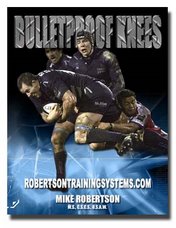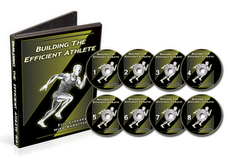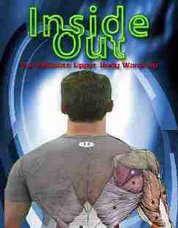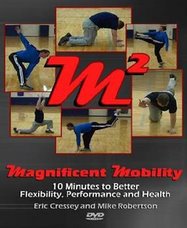Many rehabilitation "experts" would have you believe that if you strengthen your scapular retractors/depressors and stretch a little, your kyphotic posture problems would vanish. This is far from the truth. Instead of focusing on the true culprit in many cases (e.g. an anterior pelvic tilt), they focus only on the problem, not the actual cause of the problem. This local approach may work in some instances, but by failing to address the true cause, the problem will usually reoccur once rehabilitative exercise has ceased.
Anterior pelvic tilt is quite often the culprit. When you have a severe anterior pelvic tilt, the upper body has a tendency to overcompensate. Think about your spine as an "S" that must be equal on both the top and bottom. If the bottom half of the S is small and thin, the upper part will be small and thin as well. This is how a normal spine should look. However, if the bottom part of the S is very wide, the top part of the S will have to be very wide as well to compensate and balance out the bottom. Therefore, you can do all the upper body exercises and stretches you want, but until you solve the problem at the hips your results will probably always be sub-par.
So what if your hips are the problem; what can you do about it? Usually people who have issues with their hips have signs of either pelvic crossed or layer syndrome. When someone exhibits an anterior pelvic tilt, the hip flexor muscles (psoas and iliacus) are usually very tight and overactive. The psoas is usually the culprit here. Since it originates from the lumbar spine, hypertonicity and tightness create an increase in anterior pelvic tilt, which then creates a disruption throughout the low body and trunk.
This overactivity causes an inhibition of the hip extensors, primarily the glutes. When the glutes are inhibited, you often see other extensor muscle groups such as the spinal erectors or hamstrings take on the added workload left over by the inhibited glutes. Think about it: how often do you hear about someone pulling their low back or hamstrings? It’s probably an everyday occurrence in some of the larger gyms. Now think about how often you hear of someone who pulled a glute… probably not often, if ever. Not only do the hamstrings and low back have to take over an increased workload, but they also tend to get tight in the process.
Last on the list, but certainly not least, is the abdominals. If their strength isn’t up to par and the low back is shortened and tight, you have an even greater increase in lordosis. So what’s the basic premise here? Stretch the hip flexors, hamstrings and low back, while working on increasing activation and strength in the abs and glutes. Decreasing your anterior pelvic tilt can go a long way in improving your upper body posture with no direct work for the upper body whatsoever.
Read More
Mike Robertson
High Octane Corrective Exercise and Performance Enhancement | www.RobertsonTrainingSystems.com
Tuesday, December 18, 2007
Friday, December 14, 2007
QA: Dynamic Movements for The Aesthetically Inclined
Q: I realize the importance of heavy lifting for everyone, but I'm curious as to how you utilize max and dynamic movements for your clients who are not competitive lifters or athletes, but rather people interested in lifting for primarily aesthetic purposes.
A: Everyone needs to get stronger and faster, not only athletes. However, I find no point in focusing solely on strength and speed at the expense of my clients' true goals.
So heavy fives, triples, and maybe even singles would be worked into their programs from time to time. Certain cycles may focus on speed work as well. Both the client and I recognize that these are a means to an end, to help them achieve their aesthetic-based physique goals.
However, I think that speed and strength are absolutely critical. The stronger and faster you get, the more space you have for growth. It's all just part of a balanced program.
Mike Robertson
A: Everyone needs to get stronger and faster, not only athletes. However, I find no point in focusing solely on strength and speed at the expense of my clients' true goals.
So heavy fives, triples, and maybe even singles would be worked into their programs from time to time. Certain cycles may focus on speed work as well. Both the client and I recognize that these are a means to an end, to help them achieve their aesthetic-based physique goals.
However, I think that speed and strength are absolutely critical. The stronger and faster you get, the more space you have for growth. It's all just part of a balanced program.
Mike Robertson
Thursday, December 13, 2007
Always Finish With the Butt
Q: I've read your High Performance Core Training article, and I'm pretty sure that my lower back and core are my biggest weak spots. So now I'm wondering if I should avoid other hamstring related leg movements altogether when beginning this program?
Also, I'm thinking about doing higher rep pull-throughs and single leg dumbbell deadlifts, along with the other lifts you suggested, but how much time do you think I should take before getting back into heavy deadlifting?
A: This is tricky, because you want strong hamstrings, especially if you're in anterior tilt. The abs, glutes, and hamstrings work together to posteriorly tilt the pelvis. The problem arises when the hamstrings become your primary hip extensor, rather than your gluteus.
Here's how I determine how heavy to go on posterior chain movements: if I can finish the lift with my glutes (e.g. hip extension) rather than my back (lumbar hyperextension or just trunk extension), then it's a good weight. If I have to use my back rather than my ass to finish the movement, I've gone too heavy, and have shut my glutes down.
So to answer your second question, you don't have to take any time off at all: you can still pull, do good mornings, RDL's, and pull-throughs, as long as you're using your glutes to produce the movement.
Mike Robertson
Also, I'm thinking about doing higher rep pull-throughs and single leg dumbbell deadlifts, along with the other lifts you suggested, but how much time do you think I should take before getting back into heavy deadlifting?
A: This is tricky, because you want strong hamstrings, especially if you're in anterior tilt. The abs, glutes, and hamstrings work together to posteriorly tilt the pelvis. The problem arises when the hamstrings become your primary hip extensor, rather than your gluteus.
Here's how I determine how heavy to go on posterior chain movements: if I can finish the lift with my glutes (e.g. hip extension) rather than my back (lumbar hyperextension or just trunk extension), then it's a good weight. If I have to use my back rather than my ass to finish the movement, I've gone too heavy, and have shut my glutes down.
So to answer your second question, you don't have to take any time off at all: you can still pull, do good mornings, RDL's, and pull-throughs, as long as you're using your glutes to produce the movement.
Mike Robertson
Monday, December 10, 2007
Destroying the "Light Bulb" Effect
Unfortunately, I know that some of you reading this aren't currently doing any leg work in your program. There are tons of excuses out there, but none of them are making your chicken legs look any better or improving your performance.
Single-leg training is a great way to get acclimated to the rigors of heavy leg training? and who wants to show off a huge upper body paired with legs that resemble drumsticks? You don't really want to be referred to as "top heavy" the rest of your life, do you?
Read More...
Mike Robertson
Single-leg training is a great way to get acclimated to the rigors of heavy leg training? and who wants to show off a huge upper body paired with legs that resemble drumsticks? You don't really want to be referred to as "top heavy" the rest of your life, do you?
Read More...
Mike Robertson
Friday, December 7, 2007
Direct Ab Training – Fact or Fallacy?
The question comes up all the time: Do you need direct and/or isolated “core” training? Or do big bang exercises like squats, deadlifts, and overhead presses take care of this for you?
I hear this debated ALL the time – and for some reason, I think I have at least a relatively good answer as to how BOTH camps could be correct.
Let’s examine the first group, the ones who say you have to perform isolated and/or direct core training. Why would this be necessary?
You’ve heard me talk ad nauseam about core training and why it’s important; quite simply, we want to achieve and maintain optimal spinal/pelvic alignment both statically and dynamically. By doing this, we give our body the best chance to be efficient. With optimal pelvic/low back alignment, we can really turn on and utilize our glutes and hamstrings, the workhorses when it comes to big squats and deadlifts, fast sprints, and sky-high jumps.
So if you’re NOT in optimal low back/pelvic alignment, heavy squatting and deadlifting is only going to reinforce that flawed stability program. You’re going to be relying on your low back to do all the stabilizing, effectively reinforcing your already flawed spinal/pelvic alignment! This person is the ideal candidate for isolated and direct core training. They need to bring the rectus abdominus and external obliques up to appropriate levels of strength and stiffness, such that optimal pelvic alignment is achieved both statically and dynamically.
On the other hand, the “I don’t need isolated core training” group could be correct as well. How?
Quite often I hear this from lifters who have been taught to lift correctly!. They were taught to squat deep from the start. They started off training without belts for an extended period of time. One of the groups I hear this from the most is Olympic lifters. If you’ve ever worked with or watched high-level weightlifters, they generally have amazing posture: Great spinal/pelvic alignment, good thoracic mobility/extensibility, etc Basically, they are already in a near-optimal alignment, without necessarily training for it! So how could these people get away without direct core training?
They are already in optimal alignment (or close to it), and therefore their body is constantly reinforcing this optimal alignement via training. Let me expand a little further.
Let’s say our first example decides he doesn’t need isolated core training, so he takes his flawed stability patterns (e.g. all low back), and proceeds to squat and deadlift heavy. He’s already in a flawed posture, and the weight training is going to constantly reinforce and engrain that movement/posture. So while it may not catch up to him immediately, over time if he doesn’t change his ways he’s going to end up with any of an assortment of injuries.
Now let’s go back to our weightlifter. He’s already in an ideal alignment, so when he squats or deadlifts heavy, his body is going to be reinforcing that optimal alignment. Due to his core strength/stability already being on par with what his legs and hips can handle, he’s bringing up the entire body’s strength at the same time. Essentially, his entire core can stabilize whatever his legs are capable of moving. This is the perfect situation to be in.
As I’ve stated before, weight training always cements your posture. So if you’re doing it properly and through a full range of motion, it will improve your posture and your mobility! If you don’t do it correctly, or do it through an incomplete range of motion, this too will be reinforced.
To bring this to a close, just remember this – if you’re not in optimal spinal/pelvic alignment at rest, you’re not going to do it while producing movement. Period. You need to perform isolated and/or direct core strength/stability drills to achieve this first and foremost.
If you’re already in an optimal spinal/pelvic alignment, you may not need direct core work, but it probably won’t hurt.
Hopefully this sheds a little light on the topic. Best of luck with your training!
Stay strong
MR
I hear this debated ALL the time – and for some reason, I think I have at least a relatively good answer as to how BOTH camps could be correct.
Let’s examine the first group, the ones who say you have to perform isolated and/or direct core training. Why would this be necessary?
You’ve heard me talk ad nauseam about core training and why it’s important; quite simply, we want to achieve and maintain optimal spinal/pelvic alignment both statically and dynamically. By doing this, we give our body the best chance to be efficient. With optimal pelvic/low back alignment, we can really turn on and utilize our glutes and hamstrings, the workhorses when it comes to big squats and deadlifts, fast sprints, and sky-high jumps.
So if you’re NOT in optimal low back/pelvic alignment, heavy squatting and deadlifting is only going to reinforce that flawed stability program. You’re going to be relying on your low back to do all the stabilizing, effectively reinforcing your already flawed spinal/pelvic alignment! This person is the ideal candidate for isolated and direct core training. They need to bring the rectus abdominus and external obliques up to appropriate levels of strength and stiffness, such that optimal pelvic alignment is achieved both statically and dynamically.
On the other hand, the “I don’t need isolated core training” group could be correct as well. How?
Quite often I hear this from lifters who have been taught to lift correctly!. They were taught to squat deep from the start. They started off training without belts for an extended period of time. One of the groups I hear this from the most is Olympic lifters. If you’ve ever worked with or watched high-level weightlifters, they generally have amazing posture: Great spinal/pelvic alignment, good thoracic mobility/extensibility, etc Basically, they are already in a near-optimal alignment, without necessarily training for it! So how could these people get away without direct core training?
They are already in optimal alignment (or close to it), and therefore their body is constantly reinforcing this optimal alignement via training. Let me expand a little further.
Let’s say our first example decides he doesn’t need isolated core training, so he takes his flawed stability patterns (e.g. all low back), and proceeds to squat and deadlift heavy. He’s already in a flawed posture, and the weight training is going to constantly reinforce and engrain that movement/posture. So while it may not catch up to him immediately, over time if he doesn’t change his ways he’s going to end up with any of an assortment of injuries.
Now let’s go back to our weightlifter. He’s already in an ideal alignment, so when he squats or deadlifts heavy, his body is going to be reinforcing that optimal alignment. Due to his core strength/stability already being on par with what his legs and hips can handle, he’s bringing up the entire body’s strength at the same time. Essentially, his entire core can stabilize whatever his legs are capable of moving. This is the perfect situation to be in.
As I’ve stated before, weight training always cements your posture. So if you’re doing it properly and through a full range of motion, it will improve your posture and your mobility! If you don’t do it correctly, or do it through an incomplete range of motion, this too will be reinforced.
To bring this to a close, just remember this – if you’re not in optimal spinal/pelvic alignment at rest, you’re not going to do it while producing movement. Period. You need to perform isolated and/or direct core strength/stability drills to achieve this first and foremost.
If you’re already in an optimal spinal/pelvic alignment, you may not need direct core work, but it probably won’t hurt.
Hopefully this sheds a little light on the topic. Best of luck with your training!
Stay strong
MR
Monday, December 3, 2007
An Interview with Robert Dos Remedios
All -
Here's the link to a recent interview I did with strength coach Robert Dos Remedios:
http://coachdos.activeboard.com/forum.spark?forumID=112122&p=3&topicID=14448968
You have to sign-up for the board, but I think the interview will be worth it.
Mike Robertson
Here's the link to a recent interview I did with strength coach Robert Dos Remedios:
http://coachdos.activeboard.com/forum.spark?forumID=112122&p=3&topicID=14448968
You have to sign-up for the board, but I think the interview will be worth it.
Mike Robertson
The BIG Holiday Sale
You asked for it - so you got it!
You may remember our "12 Days of Christmas" sale last year was a huge success, so we've decided to run it again this year. We're offering 15% off ALL of our products.
Magnificent Mobility? Check.
Inside-Out? Yep.
Building the Efficient Athlete? For sure.
Bulletproof Knees? That too.
Any product, from now through the 12th of December, is 15% off. Purchase multiple products at the same time and save on shipping as well!
Here's all you have to do to get the discount:
1 - Go to one of the pages above, or just stop by our regular Products page
2 - Add the products you want to your cart
3 - On the right hand side of the screen, BEFORE YOU PURCHASE, enter the promotional code HOLIDAY2007
4 - Complete your order and enjoy your products!
That's it! But remember, this discount is only available through the 12th of December. Don't wait until the 13th, and then write me begging for the discount because it ain't happening!
As always, thanks for your support for Robertson Training Systems. Hopefully some of these products will be able to help you for many years to come!
Stay strong
MR
You may remember our "12 Days of Christmas" sale last year was a huge success, so we've decided to run it again this year. We're offering 15% off ALL of our products.
Magnificent Mobility? Check.
Inside-Out? Yep.
Building the Efficient Athlete? For sure.
Bulletproof Knees? That too.
Any product, from now through the 12th of December, is 15% off. Purchase multiple products at the same time and save on shipping as well!
Here's all you have to do to get the discount:
1 - Go to one of the pages above, or just stop by our regular Products page
2 - Add the products you want to your cart
3 - On the right hand side of the screen, BEFORE YOU PURCHASE, enter the promotional code HOLIDAY2007
4 - Complete your order and enjoy your products!
That's it! But remember, this discount is only available through the 12th of December. Don't wait until the 13th, and then write me begging for the discount because it ain't happening!
As always, thanks for your support for Robertson Training Systems. Hopefully some of these products will be able to help you for many years to come!
Stay strong
MR
Subscribe to:
Posts (Atom)








